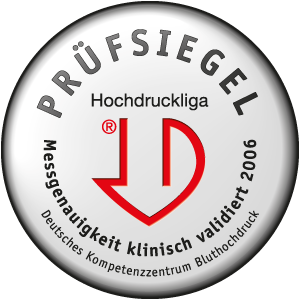




ESH-test report confirms highest quality of boso.
Only an accurate blood pressure monitor gives you certainty. When you are choosing a blood pressure instrument, pay attention to its quality standards. Professional organizations are doing independent tests of blood pressure monitors evaluating their reliability and accuracy. boso instruments were awarded for highest measurement accuracy repeatedly.
Recently the new boso series has passed the strict testing criteria of the European Hypertension of Society (ESH-IP 2010) successfully. All six devices tested were acclaimed for their precision. Also the German Hypertension Society has confirmed the high quality of boso in the past. In short: All digital boso monitoring instruments have demonstrated their measurement accuracy in independent professional tests.
General information on blood pressure and measurement

The measurement of blood pressure is one of the most important tools in the repertoire of GPs. But it is also extremely important for patients at home to check their own measurements regularly. Not only when they are taking medicine. In particular for older people and people who are health-conscious, measuring your own blood pressure daily should be a matter of course. This is because it allows early recognition of changes that suggest a deterioration of vital functions or an illness.
The blood vessels of the body form a widely interlinked, flexible system through which all the blood in the body flows. Blood is pumped into the circulation of the body by the heart, thereby providing all organs with blood rich in oxygen and nutrients.
The blood pressure is the arterial pressure measured in the vessels and chambers of the heart. The measurement of the blood pressure therefore gives information about the pressure in the arterial circulation and is therefore one of the most important diagnostic tools in the repertoire of GPs. The blood pressure is thus dependent on the performance of the heart and the resistance of the vessels. It is measured in mmHg (mm of mercury column). Two values must be calculated here: The systolic (upper) blood pressure is created when the heart contracts and the blood is pressed into the blood vessels. The diastolic (lower) blood pressure is created when the heart muscle is extended and refilling itself with blood.
One refers to high blood pressure or (arterial) hypertension if there is a sustained pressure of 140 mmHg (systolic) and/or 90 mmHG (diastolic). Many people are unaware that approximately 25% of the adult population and around half the over-60s suffer from high blood pressure. High blood pressure can exist for many years without causing any problems. However, the consequence can be serious illnesses, since in the long-term various organs such as the heart, brain, blood vessels and kidneys are damaged.
Regular blood pressure measurements have therefore acquired a high level of significance in our society and in addition to blood pressure measurement in GP surgeries, daily self-measurement of blood pressure at home has also become common. This is because only regular checks can prevent damage or circulation disorders, or recognise them soon enough to enable treatment with medication to be started, for example. In particular, people in the so-called risk groups should take their blood pressure regularly as a matter of course. Particular risk factors include e.g. inherited high blood pressure, age, overweight, diabetes, kidney diseases, stress and food rich in salt.
Measure and check your blood pressure regularly - with self-measurement devices you can also do this very easily and simply at home. In this way, you receive precise and reliable information on your health status within a few minutes. If you notice that your blood pressure is too high or you see other signs of illness, you should consult your doctor without fail.
However, a healthy diet is also always important for your health. Regular exercise and relaxation are further factors that you can use to contribute positively to your health. And note the special risk factors for high blood pressure, such as e.g. inherited high blood pressure, age, overweight, diabetes, kidney diseases, stress and food rich in salt.
On which arm should the measurement be taken?
How do you put on the cuff?
Why do blood pressure measurements sometimes vary?
And how should I evaluate the measurements?
In our "Blood pressure measurement: the basics" leaflet, we have summarized the most important information for you, briefly and succinctly – click here to download
Take advice from your doctor or from professional suppliers, i.e. chemists or medical supply stores. This is because patients who measure their blood pressure themselves should be given extensive instructions. Would you like help in assessing your blood pressure values and additional useful information? Are you perhaps measuring jointly with another person, or would you like an assessment on your smartphone or computer? Do you have an irregular heartbeat or do you need a larger cuff? There is a wide choice of different device types because accurate blood pressure measurement relies on using a device that is optimally suited to the needs of the individual. Only self-measurement that has been correctly carried out offers an excellent means of therapy control.
Some basic information for your first steps:
For self-measurement, a distinction is generally made between upper arm and wrist measurement. Both measurement methods can be considered of equal value. However, it is recommended that people with narrowed blood vessels, which is often the case for older people, should use an upper arm device, since wrist devices can under certain circumstances give imprecise measurements.
The most common self-measurement devices are entirely automatic, so that one only needs to press a button to start the measurement. The devices pump up independently - most simultaneously already calculating the high (systolic) value, so that the measurement is a very soft and pleasant process - and then automatically release the air again. At the end, systolic, diastolic and pulse measurements can be easily read on the display.
There are also devices which are particularly suitable in the case of irregular heartbeat, for example, like the classic model with built-in stethoscope - the measurement method that is often also used by doctors.
To the classic devices with stethoscope
By the way: All the measurement methods mentioned have no impact on any pacemaker. However, to verify the measurement results, comparable measurements by a doctor are recommended.
In addition to the device type, the correct cuff is one of the most important aspects for precise blood pressure measurement. So be careful to have the correct cuff size for either the upper arm or the wrist, since otherwise erroneous measurements may occur. We have an extensive choice of cuff sizes, particularly for upper arm devices, with the following choices for boso devices:
Arm circumference 16 - 22 cm - XS-cuff | 22 – 32 cm = standard cuff22 – 42 cm = universal cuff | 32 – 48 cm = XL cuff
Since we are convinced of the high quality of our products, we offer a 3-year warranty on boso self-measuring devices. Starting on the date of purchase - the original receipt is sufficient as proof.
All boso blood pressure monitors comply with the currently valid international standards and meet the strict requirements for measuring accuracy. In addition, boso blood pressure monitors have already been awarded several times for the highest measuring accuracy by the Deutsche Hochdruckliga (German High Pressure League) with their seal of approval.
Both measuring methods are to be evaluated equally and must meet the same strict requirements for measuring accuracy. However, it is recommended that people with vascular constrictions, which is particularly common in older people, use an upper arm measuring device.
The right cuff is important for reliable measurement results. For this reason, boso offers different cuff sizes for upper arm devices, as required.
Arm circumference:
For wiping disinfection (exposure time of at least 5 minutes) of the device, we recommend the disinfectant antifect liquid (Schülke & Mayr).
For disinfecting the cuff, we recommend the spray disinfection.
In particular, if the device is used by several users, pay attention to regular cleaning and disinfection of the cuff.
When using other disinfectants, there is a risk of damage to the device and cuff.
Except "boso medicus and boso medicus exclusive". These devices disinfect like mechanical sphygmomanometers.
For wiping disinfection (exposure time of at least 5 minutes) of the device, we recommend the disinfectant mikrozid sensitive liquid (Schülke & Mayr).
For disinfecting the cuff, we recommend the spray disinfection.
In particular, if the device is used by several users, pay attention to regular cleaning and disinfection of the cuff.
When using other disinfectants, there is a risk of damage to the device and cuff.
The upper arm should be undressed, but make sure that the arm is not tied off from rolling up the sleeve. It is therefore advisable that for thin and tight-fitting clothing the cuff is placed over the clothing (this does not affect the measurement result). The lower edge of the cuff should be 2 - 3 cm above the crook of the arm and the mark should be aligned with the artery. A cuff must not be too tight, there should be room for about two fingers between arm and cuff.
To know which arm is used to measure your blood pressure, first measure both arms and then always the arm whose blood pressure value is higher. Your family doctor can also help you determine the correct side.
The typical service life of the supplied batteries depends on the respective device and factors such as the individual inflation height, the frequency of use, the setting parameters, the switch-off time etc.
Batteries for upper arm devices (1.5 V mignon) usually last between 700 and 1,000 measuring cycles and batteries for wrist devices (1.5 V micro) last about half as much. Details of your personal device can be found in the technical data of the corresponding instruction manual.
For a battery-free operation, a boso power supply unit is available as an option. Please refer to the following table to find out which devices have an appropriate connection:
The measurement does not affect the pacemaker. To verify the measurement results, however, comparative measurements should be performed by a physician to ensure that the oscillation is sufficient to obtain accurate measurement results.
Blood pressure monitors which are used for commercial and business purposes must be subjected to a metrological check at least every 2 years (ich weiss nicht ob es diese MTK Regelung nur in Deutschland gibt?!?). This regulation does not apply to devices for private use. However, it is generally recommended to have these devices checked regularly, because only precise blood pressure values guarantee you a reliable health care.
In Germany, there are many boso service partners who can carry out metrological checks on your device on site.
Or you can simply send your device to us in Southern Germany:
BOSCH + SOHN GmbH u. Co. KG | Bahnhofstrasse 64 | D-72417 Jungingen GERMANY
Send the device directly to us, we will repair it immediately. If you would like a free cost estimate, please note this in your shipment:
BOSCH + SOHN GmbH u. Co. KG | Bahnhofstrasse 64 | D-72417 Jungingen GERMANY
